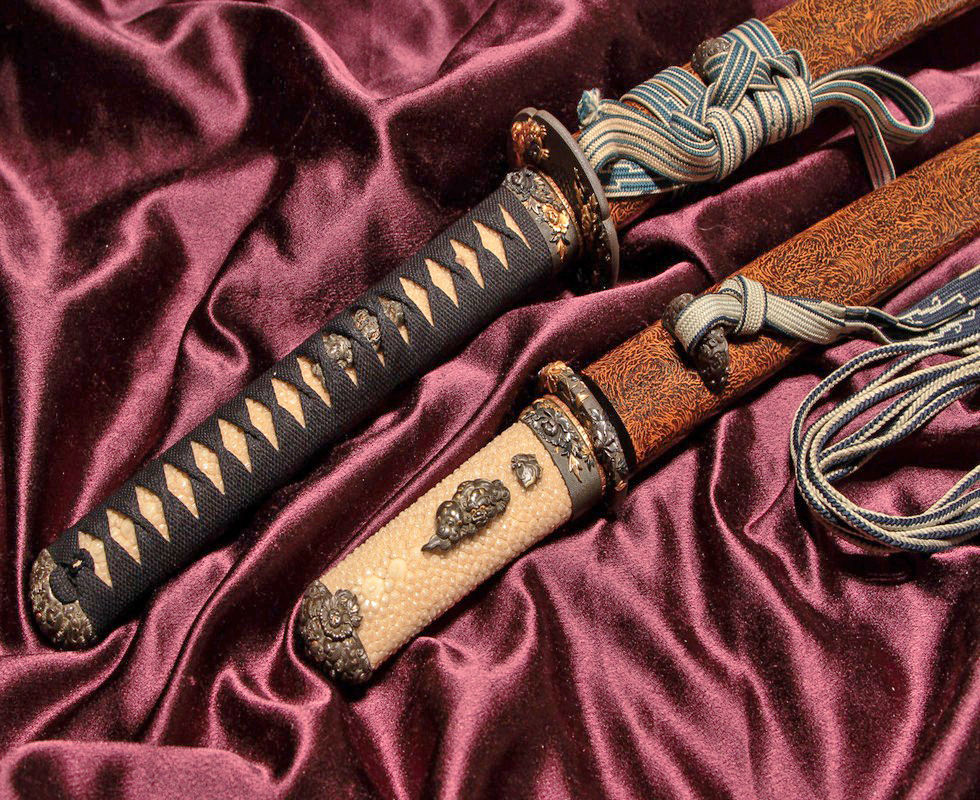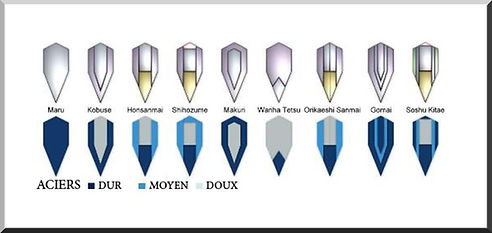
TYPES OF FORGING OF JAPANESE SABERS ACCORDING TO STEEL GRADE
WHY A FORGED BLADE?
It is the forging process that defines the type of saber blade. Katanas or authentic Samurai swords were forged by hand. Forged blades are much better quality. Forging allows a better distribution of carbon in the steel. Blacksmiths have the skill to achieve the best results. Each hand-forged blade is also unique.
-
Step 1: Forge
The forge consists of hammering one or several carbon steel ingots to obtain the shape of the blade. The hand forging guarantees the best and equal dispersion of the carbon in all the steel in order to achieve an excellent blade.
-
Step 2: Formatting
The blade which, at this stage, is still not hardened, is formed according to the required dimensions.
-
Step 3: Traditional selective quenching by clay encapsulation
To obtain a differential hardening, the blacksmith manually coats the blade with a mixture of special clay, charcoal and water, of different thicknesses. It takes very little thickness of clay on the cutting edge and more thickness of clay on the rest of the blade so as to obtain different cooling depending on the areas and therefore different hardnesses. This makes it possible to obtain a very hard "Ha" edge and a less hard "Mune" back of the blade, giving the blade a very good resistance to shocks and a very resistant cutting edge.
-
Step 4: Quench
At this stage, special know-how is required. The blade is heated to a predetermined temperature and cooled in a water bath. This step will determine the Hamon, Sori and straightness of the blade. The result mainly depends on the skill of the blacksmith.
-
Step 5: Sori, balance point and Monouchi point
The curvature "Sori", the point of balance and the point "Monouchi" will be determined according to the use for which the sword will have been forged: realization of Kata, practice of Tameshigiri or Battodo.
-
Step 5: Polishing
Polishing is done manually to provide an excellent finish and reveal the "Hamon" temper line as well as the grain and structure of the steel.
STEELS
THE SHINGANE (soft steel):This is the heart of the blade. Made of steel, it is flexible and bends rather than breaks. However, being too soft, it could not constitute the entire blade, which would not cut. It is also called "Shintetsu". The presence of shigane in the core gives the blade its elasticity.
THE KAWAGANE (Intermediate steel):There are a large number of different laminations combining 2 or 3 of these intermediate metals.
THE HAGANE (Hard steel):Made of steel, it is brittle but very hard and sharp. It is often folded around the Shigane. Also called "Uagane".
THE DIFFERENT TYPES OF STEEL ASSEMBLIES FOR MAKING A BLADE
It is known that the blades of sabers are made of laminations of several different metals, whether they are hard steels (Hagane), intermediate steels (Kawagane) or soft steels (Shingane). In addition to blades made with a single folded steel, high quality Japanese swords are also composed of different distinct layers of different types of steel (more or less hard). This manufacturing technique uses different types of steel, to accentuate the desired characteristics in different parts of the sword, beyond the level offered by differential heat treatment (Tempering).
ASSEMBLIES
There are almost an infinite number of ways steels could be joined, which often vary greatly from smith to smith. Typically the harder steel bar is hammered, stretched and bent into a "U", then the very soft base steel is inserted into the "U". Then they are forged and hammered to weld them together, while giving the basic shape of the blade. At the end of the process, the two pieces of steel are fused together, but retain their differences in hardenability. The most complex types of construction are generally found on older blades, with the vast majority of modern weapons being comprised of a single section or at most two or three sections. Another way to proceed is to assemble the different parts into a block, by forging and welding them together, then stretching the steel to make a blade, so that the different steels are correctly distributed. This method is often used for complex models, it allows to have a blade with which one can parry without fear of damaging the edge of the blade. For the Honsanmai or Shihozume types, pieces of hard steel are added to the outside of the blade in a similar manner. Shihozume and Soshu types are quite rare.
THE DIFFERENT TYPES OF FORGING ACCORDING TO STEEL GRADES
-
MARU:The vast majority of modern Katana and Wakizashi are Maru type (Sometimes also called Muku), this is the most common type of blades, they are blades forged only_cc781905-5cde-3194-bb3b -136bad5cf58d_ in hard steels. These are monoblocks from Hagane. This is the poorest composition.
-
KOBUSE : The Kobuse blade type is made using two steels, (Called Hagane : edge steels) and Shingane (Base Steel). ont a core of mild steel, wrapped around the sides and cutting edge by very hard steel. This composition was used during World War II and is still in use.
-
HONSANMAI(San Mai) :For Honsanmai types we add a third steel, (Kawagane : skin steel). These blades have the most common composition: 4 ingots, a core and back in mild steel, sides in hard steel, cutting edge in very hard steel.
-
TAMAHAGANE:The blade is forged from 2 types of steel, the softer is placed within the harder. This art of forging stems from the Japanese model Tamahagane which is taught, in Japan, only to the best blacksmiths and this for centuries. The two steels, folded forged (26,000 sheets) and tempered using the traditional clay coating technique, reveal martensite and Hamon crystals. This is only made visible on the blades by manual polishing.
-
SOSHU KITAE:Are blades made of different steels. There are 7 ingots and 3 steel densities. We find a soft steel core, the internal face of the sides of hard steel, the back, the external face of the sides and the cutting edge of very hard steel. Masamune forged his blades from Soshu-kitae. It is the most complex composite and a real feat for a blacksmith.
-
SHIHOZUME:Blades have 5 ingots, soft steel core, hard steel back and sides, very hard steel cutting edge.
-
Makuri:The blades have a mild steel core wrapped entirely in very hard steel.
-
WARIHA TETSU:The blades have hard steel back, very hard steel cutting edge (Generally for Wakisashi and Tanto).
-
ORIKAESHI SANMAI:The blades are made of 6 ingots.
-
GOMAI :The blades have a very hard steel core, a mild steel inner casing, a very hard steel outer casing.
THE MAIN TYPES OF FORGING










